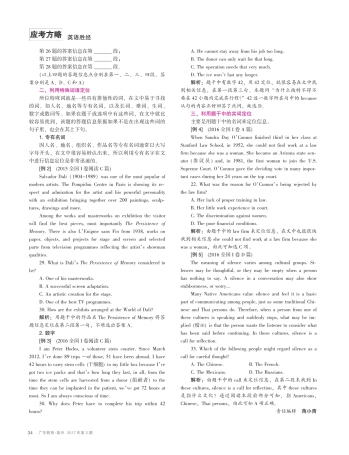第27题的答案信息在第_______段;
第28题的答案信息在第_______段。
(以上四题的答题信息点分别在第一、二、三、四段。答案分别是A、D、C和A)
二、利用特殊词语定位
所位特殊词就是一些具有排他性的词,在文中易于寻找的词。如人名、地名等专有名词,以及长词、难词、生词、数字或数词等。如果在题干或选项中有这些词,在文中就比较容易找到,该题的答题信息依据如果不是在出现这些词的句子里,也会在其上下句。
1. 专有名词
因人名、地名、组织名、作品名等专有名词通常以大写字母开头,在文中很容易辩认出来,所以利用专有名字在文中进行信息定位是非常迅速的。
[例2](2015全国I卷阅读C篇)
Salvador Dali(1904~1989)was one of the most popular of modern artists. The Pompidou Centre in Paris is showing its respect and admiration for the artist and his powerful personality with an exhibition bringing together over 200 paintings, sculptures, drawings and more.
Among the works and masterworks on exhibition the visitor will find the best pieces, most importantly The Persistence of Memory. There is also L’Enigme sans Fin from 1938, works on paper, objects, and projects for stage and screen and selected parts from television programmes reflecting the artist’s showman qualities.
29. What is Dali’s The Persistence of Memory considered to be?
A. One of his masterworks.
B. A successful screen adaptation.
C. An artistic creation for the stage.
D. One of the best TV programmes.
30. How are the exhibits arranged at the World of Dali?
解析:用题干中的作品名The Persistence of Memory将答题信息定位在第二段第一句,不难选出答案A。
2. 数字
[例3](2016全国I卷阅读C篇)
I am Peter Hodes, a volunteer stem courier. Since March 2012, I’ve done 89 trips —of those, 51 have been abroad. I have 42 hours to carry stem cells(干细胞)in my little box because I’ve got two ice packs and that’s how long they last, in all, from the time the stem cells are harvested from a donor(捐献者)to the time they can be implanted in the patient, we’ve got 72 hours at most. So I am always conscious of time.
30. Why does Peter have to complete his trip within 42 hours?
A. He cannot stay away from his job too long.
B. The donor can only wait for that long.
C. The operation needs that very much.
D. The ice won’t last any longer.
解析:题干中有数字42,用42定位,就很容易在文中找到相关信息,在第一段第三句。本题问“为什么彼特不得不要在42小题内完成其行程?”42这一数字所在句中的because从句的内容正好回答了此问,故选D。
三、利用题干中的实词定位
主要是用题干中的名词来定位信息。
[例4](2016全国I卷A篇)
When Sandra Day O’Connor finished third in her class at Stanford Law School, in 1952, she could not find work at a law firm because she was a woman. She became an Arizona state senator(参议员) and, in 1981, the first woman to join the U.S. Supreme Court. O’Connor gave the deciding vote in many important cases during her 24 years on the top court.
22. What was the reason for O’Connor’s being rejected by the law firm?
A. Her lack of proper training in law.
B. Her little work experience in court.
C. The discrimination against women.
D. The poor financial conditions.
解析:由题干中的law firm来定位信息,在文中也能很快找到相关信息she could not find work at a law firm because she was a woman,由此可知选C项。
[例5](2016全国I卷D篇)
The meaning of silence varies among cultural groups. Silences may be thoughtful, or they may be empty when a person has nothing to say. A silence in a conversation may also show stubbornness, or worry...
Many Native Americans value silence and feel it is a basic part of communicating among people, just as some traditional Chinese and Thai persons do. Therefore, when a person from one of these cultures is speaking and suddenly stops, what may be implied(暗示)is that the person wants the listener to consider what has been said before continuing. In these cultures, silence is a call for reflection.
33. Which of the following people might regard silence as a call for careful thought?
A. The Chinese. B. The French.
C. The Mexicans. D. The Russians.
解析:由题干中的call来定位信息,在第二段末找到In these cultures, silence is a call for reflection,其中these cultures是指什么文化?通过阅读本段前部分可知,指Americans,Chinese,Thai persons,由此可知A项正确。
责任编辑 蒋小青


